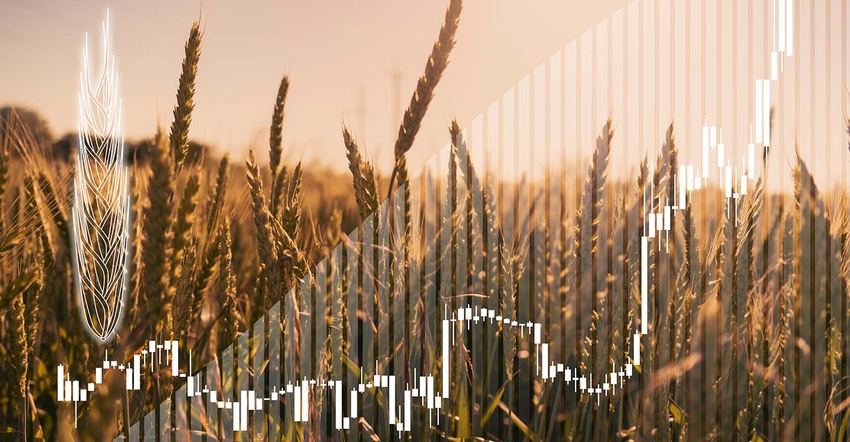
Editor’s note: This is part 14 in a series discussing how to use options to enhance your grain marketing.
Dan contracted 5,000 bushels of wheat at $11.00 on a HTA and bought the $9 and $10 puts for 29 cents each.
Joe contracted 5,000 bushels of wheat at $11.00 on a HTA and bought the $10 and $11 puts for 59 cents each.
Don did not sell the futures or HTA, but bought a $9 put for 29 cents and then, when the futures gained a dollar, he bought a $10 put for 29 cents.
Junior did not sell futures or HTA, but bought the $10 put for 59 cents and after the market rallied a dollar, Junior bought the $11 put for 59 cents.
The chart below shows the futures price and put values on July 8 on the left and the same for July 15 on the right. September wheat was down $1.14½. If you do not know that means the puts increased in value, you need to go back to lesson one.
Example 1: Dan
Dan paid 29 cents per bushel for two options. That would be 10,000 option bushels at 29 cents for a total option cost of $2,900.
As of July 15, the $9.00 put was worth $6,243.75. The $10 put was worth $11,168.75. Together, those puts were worth $17,512.50.
Dan paid $2900 for the pair, so his net profit on Friday’s close was $14,612.50.
Divide the put profit by 5,000 bushels he contracted; he has $2.92 to add to his HTA price of $11.00. That moves his HTA to $13.92 net HTA price. Not bad considering he sold his wheat $2.85 below the contract high of $12.85 made on May 17.
Yes, Ladies and Gentlemen, his net price for his wheat is $2.07 higher than the contract high. In 1990, a competing merchandiser, who would not buy the puts for my clients, told one of my farmer clients “that had to be illegal.” No, being paid a price above the high for the year is not illegal if it was earned.
Perhaps better yet, every cent wheat moves lower, Dan’s net selling price will increase about 2 cents because the puts’ value will increase about one cent each for a one cent decline in the futures price. Of course, the opposite is true if wheat goes higher. Dan could close out the options by selling now and be satisfied with $13.92 or go for more, but risk getting less.
Example 2: Joe
Joe paid 59 cents per bushel for two options. That would be 10,000 option bushels at 59 cents for a total option cost of $5,900.
As of July 15, the $10.00 put was worth $11,168.25. The $11 put was worth $16,168.25. Together, those puts were worth $27,336.50.
Joe paid $5900 for the pair, so his net profit on Friday’s close was $21,436.50. Divide the put profit by the 5,000 bushels he contracted and he has $4.28 to add to his HTA price of $11.00. That puts him at $15.28 net HTA price. Not a bad price for selling his wheat $2.85 below the contract high of $12.85.
Don and Junior: No HTA or forward contracts
Don bought the cheap puts the same as Dan, and Junior bought the expensive puts same as Joe, but neither of them contracted wheat on an HTA or forward contract. How are they doing?
Don’s cheap puts had the same profit as Dan’s puts, $2.92 a bushel. The September futures settled at $7.76¾ on Friday, so Don’s net HTA price that day was $10.69 ($7.77 futures price +$2.92 option profit).
Junior’s expensive puts had a net profit of $4.28 per bushel to make his wheat worth $12.05.
After Don and Junior bought a put, they did not particularly care if wheat went higher or lower because either way, they were going to increase their wheat price. If the futures went higher and stayed there, the puts would expire worthless and they would be selling wheat for a price above the floor established by the puts. If wheat futures declined, the puts increased the value of his wheat.
The seasonal wheat price trend turns up in late August. September options expire this year on Aug. 26. So, it is time to start the search for a futures price near the contract low to sell the puts. Fortunately, futures prices usually spend several months near the low. It is a lot easier to pick a price near the low than it is to pick a price near the high. That will be next week’s topic.
This is part 14 in a series. To learn more, read:
Part one: Put options add value to your cash grain sales
Part two: Hedge your crops with no margin calls
Part three: Enhance profit opportunities with put options
Part four: Put options and no margin calls
Part five: When does a put option have no potential value?
Part six: Why are put options so expensive?
Part seven: Use puts to manage grain marketing risk
Part eight: What is time value of an option?
Part nine: How to calculate time value of an option
Part ten: Use puts with Hedge-to-Arrive to increase farm income
Part eleven: Sample timeline to explain how wheat puts work
Part twelve: Put options compliment futures contracts
Part thirteen: Put options: Understand premium and delta
Wright is an Ohio-based grain marketing consultant. Contact him at (937) 605-1061 or [email protected]. Read more insights at www.wrightonthemarket.com.
No one associated with Wright on the Market is a cash grain broker nor a futures market broker. All information presented is researched and believed to be true and correct, but nothing is 100% in this business.
The opinions of the author are not necessarily those of Farm Futures or Farm Progress.
About the Author(s)
You May Also Like






